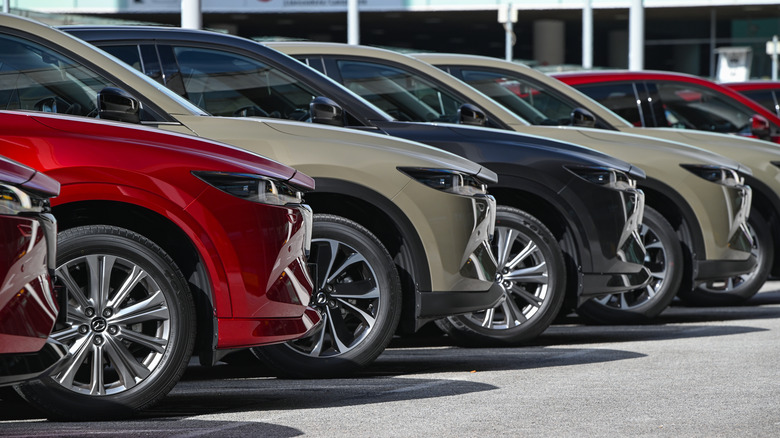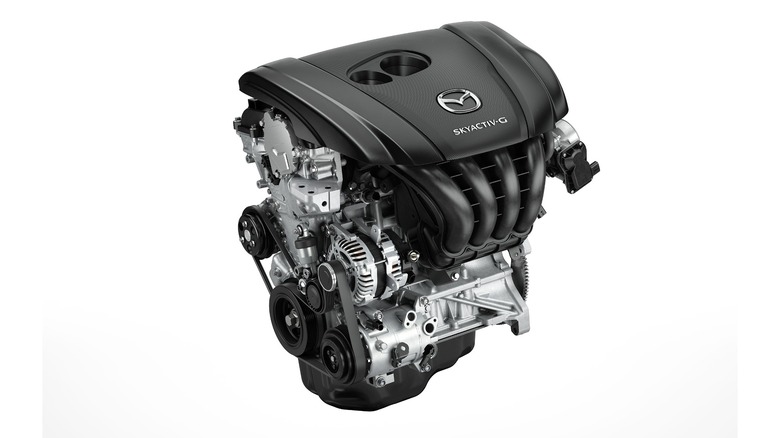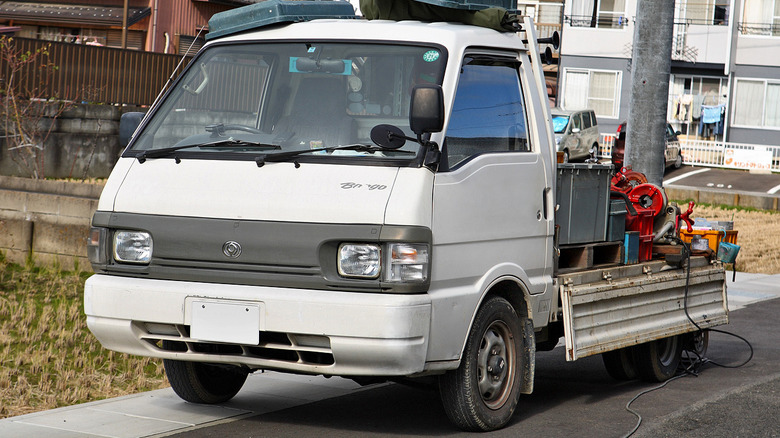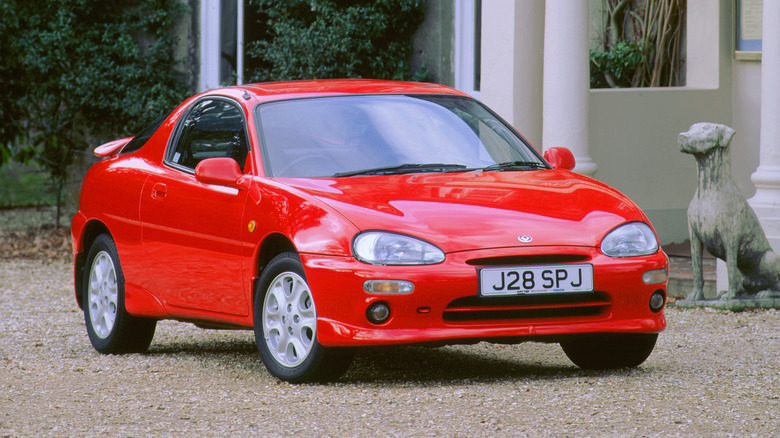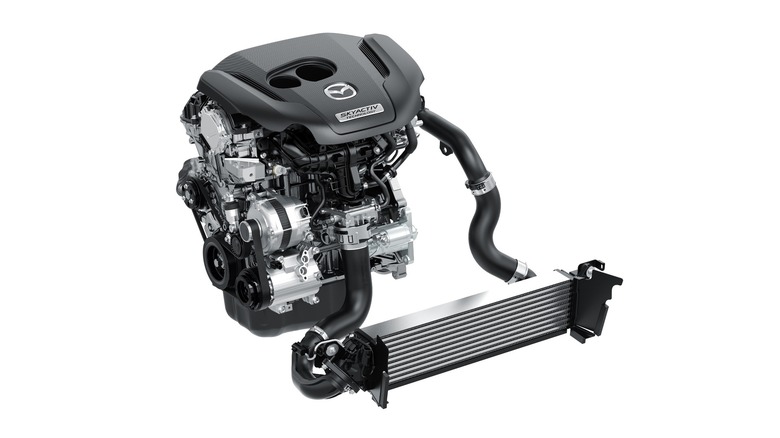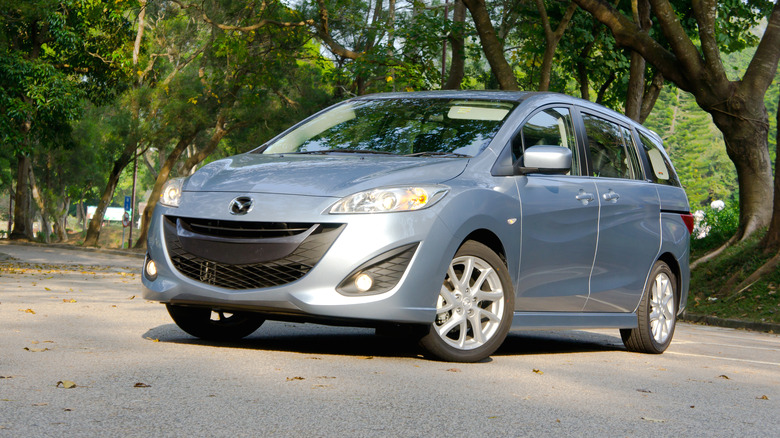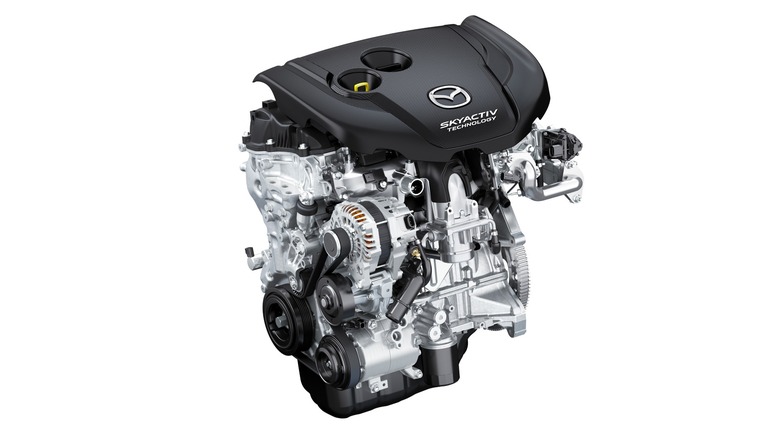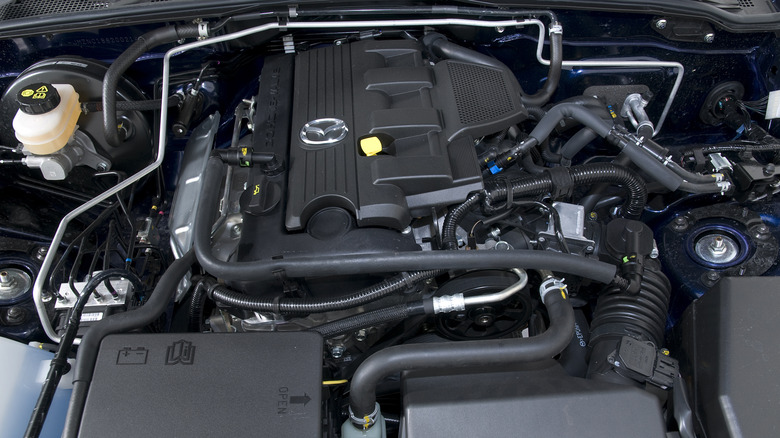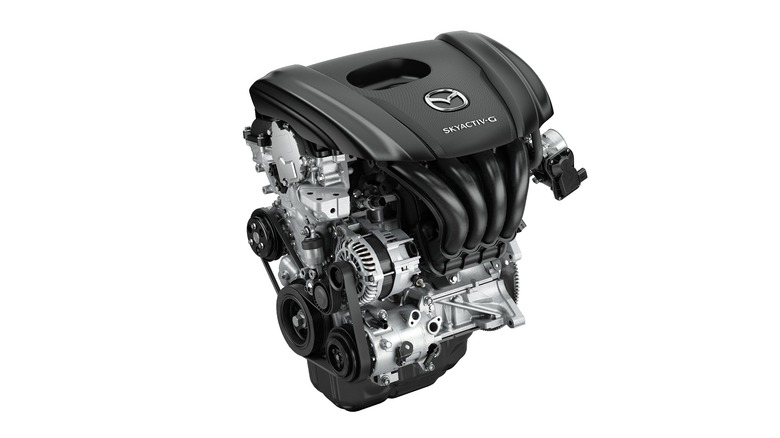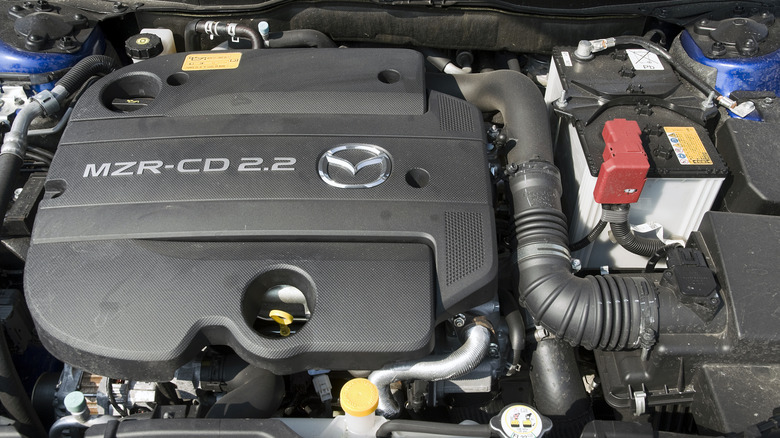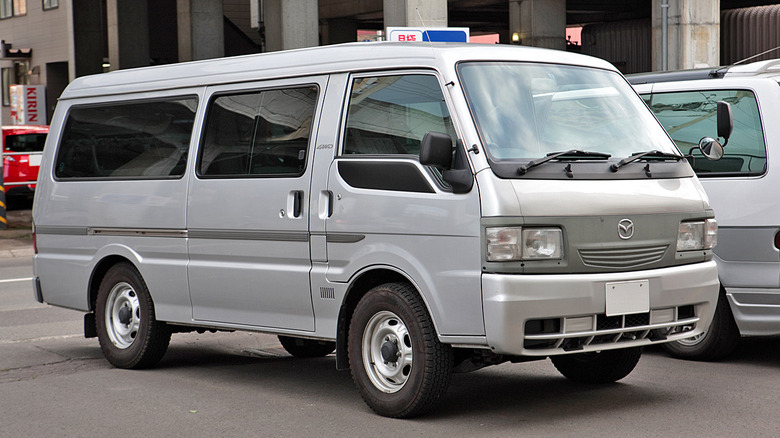10 Of The Most Reliable Mazda Engines Ever Built
Unlike many other car manufacturers, Mazda isn't placing all its bets on electric cars. While it's slowly been expanding its EV lineup in recent years, it only claims to be working towards a fully electrified range by 2030 that includes mild hybrids and full hybrids, alongside a lineup of all-electric vehicles. That makes it one of the few manufacturers to be continuing its development of combustion engines rather than phasing them out, but perhaps this was to be expected.
After all, the automaker has carved out a reputation over the decades as delivering consistently strong gas and diesel powertrains, with its engines powering everything from lightweight roadsters to commercial trucks and vans. It has only ever made a handful of engines that could be considered truly unreliable, with the vast majority seeing decades of service and hundreds of thousands of miles racked up with little or no complaint. These are the best workhorse Mazda engines from past and present.
Mazda 2.0L Skyactiv-G
The gas-powered Skyactiv-G engine line has, in general, proven to be extremely reliable since it was first introduced in 2011, with the 2.0L version featuring in best-selling cars like the CX-5 crossover and the American market ND MX-5 Miata. As well as being a fun weekend toy, the Miata makes for a surprisingly capable long-distance commuter that also looks good while on the highway, with one owner racking up more than 163,000 miles without issue in less than five years of ownership.
This longevity doesn't come at the cost of driving dynamics, either, as the current-generation Miata remains among the most fun affordable sports cars on the market. SlashGear noted that, although the 181 horsepower on offer from the engine might not seem like much on paper, the light weight of the Miata makes it sprightlier to drive than cars with double the horses under the hood.
Mazda 1.8L F8
The F8 engine remained in production in various Mazda and Kia models from 1982 right up to 2005 and first appeared in the Mazda 626 and Capella. It also saw service in the brand's line of Bongo vans across the Bongo 3 and Bongo 4, between 1983 and 2005. It might not have been one of the brand's most exciting engines in terms of performance characteristics, but it was a reliable workhorse and could put up with the abuse and high mileage associated with powering a commercial vehicle.
Kia relied on Mazda for its engines throughout the '80s and '90s, and both the Capital and Concord sedans used a variant of the F8 engine throughout their respective lifespans. The F8 and its various sub-variants were mostly phased out in passenger cars by Mazda by the mid-'90s, but its dependability saw it stick around in the Bongo lineup until tightening emissions regulations in Japan forced Mazda to update the van with cleaner gas and diesel engines.
Mazda 1.8L K6
Arguably, any of the K-Series V6 engines could have ranked highly here, but the smallest 1.8L V6 is especially worthy of mention because of its tough build and small size. Fitted to the MX-3 sports coupe, the engine was developed to avoid high taxes on larger engines at home in Japan. It was developed close to the peak of Japanese over-engineering, and so its high-strength steel and aluminum construction was considerably more bulletproof than it had any right to be.
The MX-3 never made the impact on the market that Mazda undoubtedly hoped it would, in part thanks to the wealth of other well-built Japanese sports cars on the market at the time. Eventually, Mazda handed development rights to the line over to Ford as part of a parts-sharing deal, where it evolved into the Duratec V6 design. However, the days of sub-2.0L V6 engines never returned under Ford, leaving the K6 as a unique testament to Mazda's engineering prowess.
Mazda 2.5L Skyactiv-G
The 2.5L turbocharged version of Mazda's gas-powered Skyactiv engine saw its exceptional design win a Wards 10 Best Engines award in 2017. The design features a unique butterfly valve in the exhaust that helps the turbo spool up quickly, giving it quicker off-the-line performance than many of its rivals. The engine was fitted in a number of family-friendly crossovers, including the CX-5 and CX-9, and Mazda claims it designed it specifically for urban driving since that's where most of its crossovers will spend the majority of their time.
SlashGear tested the CX-9 in 2021 and found the engine to be exceptionally fun for the segment, especially since the car's handling was athletic enough to match the sportiness of its powertrain. The engine wasn't the most efficient in the segment but otherwise had no faults. As the most recently-launched Mazda engine line, the Skyactiv engines are likely to continue to be further developed as Mazda continues to fine-tune its range of SUVs and crossovers.
Mazda 2.0L LFF7
It won't win any awards for performance, but the 2.0L LFF7 engine fitted to the first-generation Mazda6, has a reputation for soldiering on for years with minimal fuss and impressively low maintenance costs. It made between 140 and 150 horsepower and up to 140 lb-ft of torque, and served as the base engine option for the Mazda6. It also appeared in Mazda5 models between 2004 and 2011. Unlike Mazda's highly reliable modern Skyactiv engines, the LFF7 never prioritized driver enjoyment, making it one of the brand's more forgettable powerplants.
Nonetheless, its status as an unfussy workhorse was undoubtedly appreciated by the many drivers relying on their Mazda6 and Mazda5 cars as affordable, dependable daily drivers, even if few will have given much thought to the engine under the hood. It was eventually retired in 2011 after the new Skyactiv engine range was launched across the brand's lineup.
Mazda 2.2L Skyactiv-D
When the 2.2L Skyactiv-D first launched a decade or so ago, it was hailed as class-leading thanks to its low emissions, fuel-sipping efficiency, and torquey nature. Not much has changed since then: it's still a great engine and one that's proved to be very reliable over the years, with owners racking up six-figure mileages without issue.
It's seen service in a wide range of Mazda's top-selling models in the years since, including in the Mazda3 hatchback, the Mazda6 sedan, and crossovers including the CX-5 and CX-8. Like Mazdas' gas-powered Skyactiv-G engines, it manages to balance performance with efficiency in a way that means drivers can put their foot down when needed without having to worry about breaking the bank at the fuel pump. It remains available across much of Mazda's global range, although sadly not in the U.S. — the American-market diesel CX-5 was axed in 2021 after just a year on sale due to low demand.
Mazda 2.0L LF-DE/VE
The LF-DE is a relatively uncommon engine in Mazda's L-Series, being only used in the BK series Mazda3. It's very closely related to the LF-VE that features in the NC Miata and BL Mazda3, with the main difference being that the latter engine has variable valve timing. The LF-DE was only produced between 2004 and 2006 and made around 139 horsepower in its original incarnation. In LF-VE form, it hung around until the retirement of the NC Miata in 2015, with a still-modest 158 horsepower on offer.
A quick search of any major used car site will show plenty of high-mileage examples of both the NC Miata and Mazda3, and it's likely that even the highest mileage examples will still have plenty of life left in them if they've been maintained correctly. Assuming it has been, the engine can reach well north of 200,000 miles without requiring major repairs.
Mazda 1.5L Skyactiv-G
The smallest variant of the Skyactiv-G engine is no less reliable than its larger siblings, and it features in a range of models including the Mazda2, Mazda3, Japanese-market Miata, and CX-3. With its smaller size comes a smaller power output, and in its base-spec form, it only makes 74 horsepower. Luckily, in that low spec, it only has the relatively diminutive weight of the Mazda2 to haul around. That makes it more than capable as an urban runabout.
The 1.5L engine was deemed to be not powerful enough for American Miata buyers, so the USDM car gets the 2.0L Skyactiv engine instead. Likewise, the U.S. Mazda3's base engine is the 2.5L with a much more competitive 191 horsepower, and the Mazda2 isn't sold in the U.S. at all. Incidentally, both of those versions of Mazda's excellent engine line also feature here as top picks for reliability, so U.S. buyers aren't missing out on much by not being able to get their hands on the smallest of the bunch.
Mazda 2.2L R2 MZR-CD
The Mazda3 was also previously available with another of the brand's most dependable engines, the 2.2L R2 MZR-CD. It was available in select markets for the Mazda3 for the 2009 to 2013 model years and also appeared in the CX-7 and Mazda6. It proved to be an excellent highway cruiser, even if it was never very exciting to drive.
It's worth noting that the engine in the 2008 model year Mazda6 was not quite as reliable as the following model years due to reports of faulty seals, but all other years were unaffected. Teething troubles aside, the engine gained a reputation as one of the best diesels in its segment, even if cars like the CX-7 struggled to stand out in what was, at the time, a packed field of competitors. Thanks to a general lack of interest from American buyers, the diesel CX-7 was never sold Stateside at all, with buyers having to make do with a choice of gasoline engines.
Mazda 2.5L WL-T
Another under-the-radar workhorse, the 2.5L WL-T diesel engine featured in a range of Mazda and Ford models between 1995 and 2006. It saw service in the first generation of the Ford Ranger pickup, along with the mid-'90s Freda, Raider, and Courier. It was also available as the diesel option in the Mazda Bongo 4 between 1995 and 2005, incidentally alongside the gas-powered K8, which also features on this list.
Various B-Series trucks also saw the 2.5L WL-T as an option, with up to 130 horsepower on tap in the most powerful models. If it's maintained correctly, the engine's expected lifespan was north of 300,000 miles. However, thanks to the hard lives that the likes of the Ranger and Bongo endured, many vehicles with the engine were scrapped due to wear and tear before the engine ever wore out. Much like the K8, tightening emissions regulations in key markets forced Mazda to retire the 2.5L WL-T.
